Solar Orbiter Mission Development
People and News
Development Status
• 7 February 2020: After months of intense simulation training, two delays at the launch pad and a dress rehearsal, the Solar Orbiter control teams at ESA's mission control are ready for the Sun. 1)
- Solar Orbiter will take the first direct images of the Sun's poles, but getting into the right orbit to do this means taking a loopy path through the inner Solar System, borrowing thrust from the powerful gravitational fields of Earth and Venus.
- Teams of spacecraft operations engineers, flight dynamics experts, software and ground station engineers have spent months preparing for this ten year journey to explore the Sun, and can now confirm they are "green for launch".
- Solar Orbiter was originally set to launch on 6 February 2020, Central European Time. However an issue with the launcher's ‘Wet Dress Rehearsal' at the Cape Canaveral launch site in Florida, meant it was delayed.
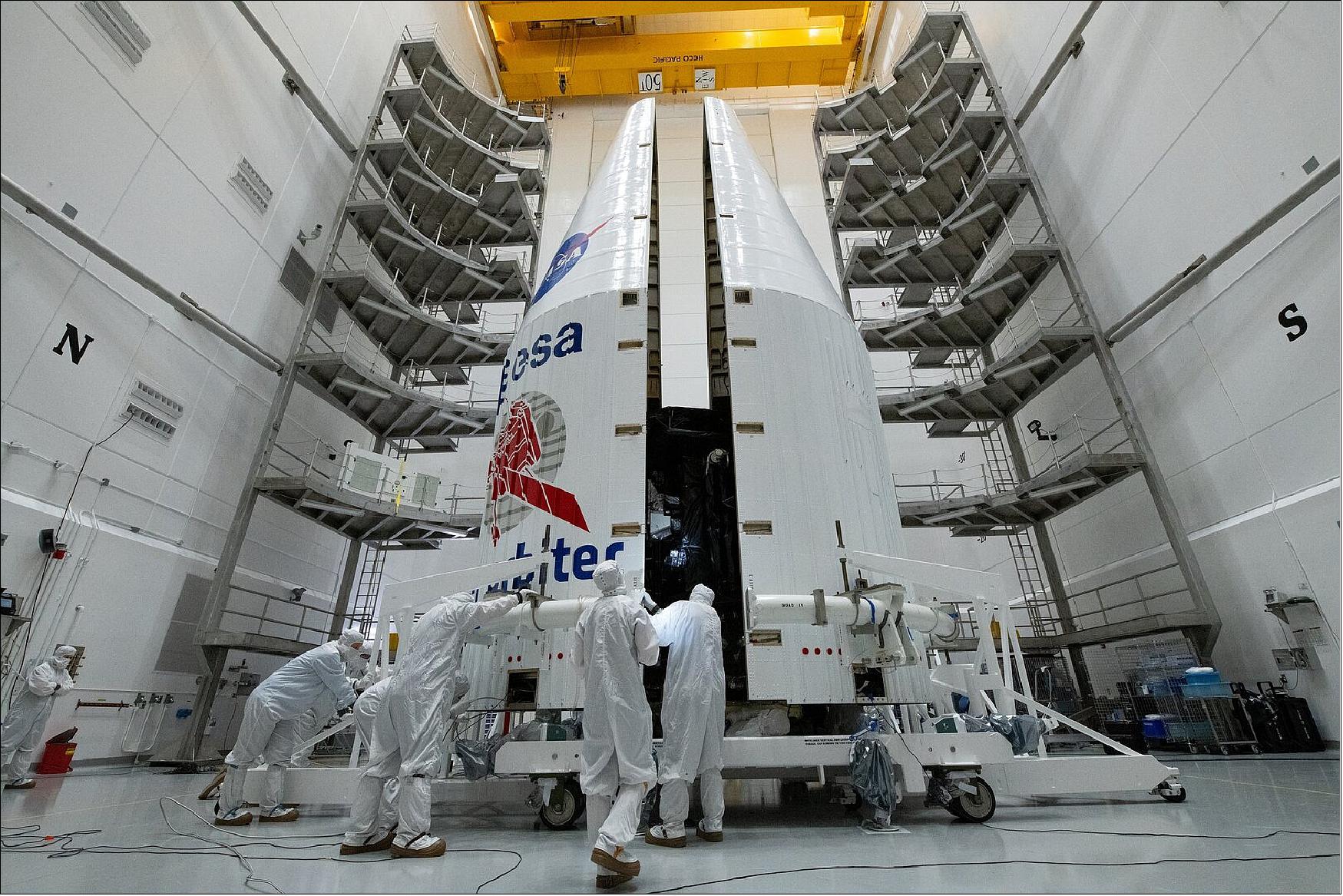
• February 3, 2020: ESA's new Sun-explorer, Solar Orbiter, will capture close-up images of never before seen regions of our parent star, including the poles, and study the electromagnetic environment in its vicinity. The cutting-edge spacecraft will get as close as 42 million kilometers away from the Sun, about a quarter of the distance between the Sun and Earth, and face scorching temperatures of up to 500ºC. 2)
- ESA has a long history of studying the Sun from space. Since the launch of Ulysses in 1990, the agency has led or cooperated on several Sun-exploring missions including SOHO, the Cluster quartet and PROBA-2.
- The A and B roll features ESA's archive material tracing the agency's past missions to the Sun.
- The B roll contains new cleanroom footage showing the early stages of integration of Solar Orbiter into the upper stage of the Atlas V launcher. The B-roll also contains newly re-digitized ESA archive material.
• January 21, 2020: Today, the Solar Orbiter control team is simulating launch for the penultimate time, before the Sun-seeking spacecraft lifts-off for real. 3)
- After months of nerve-wracking simulation training, which has seen the control team play out a range of scenarios where something goes wrong, mission control is almost "green for launch".
- On 6 February (CET), Solar Orbiter will begin its loopy journey through space on the way to the Sun.

- With the help of gravitational assists from Earth and Venus, and a series of chemical thruster burns, the spacecraft will reach a unique high-inclination orbit that will allow it to take the first pictures of the Sun's poles.
- Reaching this orbit, and safeguarding the spacecraft from the intense heat and radiation as it carries out its scientific mission, will require tricky operations back on Earth.
Simulating a Boom!
- To ensure Solar Orbiter's safety as best they can, teams at ESA/ESOC mission control are currently rehearsing the Launch and Early Orbit Phase (LEOP) of the spacecraft's mission, during which time the spacecraft ‘wakes up' and solar panels and instrument booms are deployed.
- This is a critical and risky part of the mission's lifetime, and the teams will need to be prepared for every eventuality.
- No two missions flown from the Operations Center are the same. Every mission brings with it a unique set of challenges that can be explored during simulations. For Solar Orbiter, during LEOP, the craft has to deploy a ‘boom'.
- Measuring 4.4 meters in length when fully extended, this tail-like extension carries four of Solar Orbiter's scientific measuring instruments.
- "The booms are deployed before all thrusters can be fired on the spacecraft, as some thrusters can potentially contaminate the instruments onboard," explains Andrea Accomazzo, Flight Director for the mission.
- "The sooner all thrusters can be fired, the more efficiently they can be used and more fuel can be saved".
- This makes the first few days after launch particularly time sensitive. While some thrusters are used immediately to control the spacecraft's orientation, or ‘attitude', if the boom fails to deploy on time, the craft could be more restricted in which thrusters to use without risk of contamination.
Fail to Prepare and Prepare to Fail
- LEOP simulations began on 10 September 2019 in which teams brainstormed boom deployment and other challenging events.
- These could be anything that destabilizes the control team, such as a team member suddenly becoming sick or a computer crashing, to critical errors that threaten the safety of the mission, such as a failure to establish communication with the spacecraft or a problem deploying its solar panels.
- The final two simulations will see the control team – split into two, to provide round-the clock operations during the high-stress early days of the mission – run through a ‘nominal' launch and early orbit, in which everything goes to plan. Today is the turn of the blue team, and on 23 January, the green team.
- Finally, the dress rehearsal will take place on 31 January, during which time teams at mission control run through the launch sequence and test communication between mission control, the launch provider and of course, the satellite, just days before launch.

- "The first few days of the mission are challenging and exciting! After our intense training in recent months, the team is hopefully ready to tackle any issue which may arise," explains Sylvain Lodiot, Spacecraft Operations Manager for the mission.
- Fortunately, we have more than 100 years of combined experience flying space missions in our division, from the Rosetta landing, to BepiColombo and Venus Express. We're now looking forward to seeing the Sun in a light no-one has before".
• November 21, 2019: ESA's mission to the Sun has been unpacked following its arrival in Florida earlier this month, ready to begin pre-launch testing and checks. 4)
- The mission is currently scheduled to lift off from Cape Canaveral launch complex late in the evening of 5 February U.S. time (early morning 6 February central European time) on an unprecedented mission to study our star up-close.
- An Antonov cargo plane transported the spacecraft and essential ground support equipment from Munich, Germany, to Florida, landing at the Shuttle Landing Facility at Kennedy Space Center on 1 November. From there the satellite and equipment travelled by road to the AstroTech Space Operations facility. The first weeks were dedicated to setting up the equipment that will be needed to perform the upcoming checks and tests on the spacecraft. This will include repeated simplified tests of the spacecraft and science instruments so that the functioning of the various systems is confirmed as it was before the long flight, and checking of the propellant pressurization system pressure before eventually fueling the spacecraft.
- In the new year attention will shift to mating the spacecraft with the launch adapter and encapsulating the spacecraft inside the fairing. In the final stages of preparation, the spacecraft will be mounted atop the Atlas V 411 rocket and moved to the launch pad ready for liftoff.

- Once in space, and over the course of several years, the spacecraft will repeatedly use the gravity of Venus and Earth to raise its orbit above the poles of the Sun, providing new perspectives on our star, including the first images of the Sun's polar regions. Its complementary suite of instruments means it will be able to study the plasma environment locally around the spacecraft and collect data from the Sun from afar, connecting the dots between the Sun's activity and the space environment in the inner Solar System, which is essential to understand the effects of space weather at Earth.
- Solar Orbiter is an ESA mission with strong NASA participation. The prime contractor is Airbus Defence and Space in Stevenage, UK. The mission will provide complementary datasets to NASA's Parker Solar Probe that will allow more science to be distilled from the two missions than either could achieve on their own.
• October 18, 2019: ESA's Solar Orbiter mission has completed its test campaign in Europe and is now being packed ready for its journey to Cape Canaveral at the end of this month, ahead of launch in February 2020. 5)

- The spacecraft was on display today for the final time in Europe, at the IABG test center. It was built at Airbus Stevenage, UK, and has spent the last year at IABG undergoing essential testing such as checking deployment mechanisms, and that it can withstand the vibrations of launch, and the thermal extremes and vacuum of space. It has now been declared ready for shipment to the launch site and will travel an Antonov cargo plane on 31 October.
- Once launched it will follow an elliptical path around the Sun, at its closest bringing it within the orbit of Mercury, just 42 million kilometers from the Sun. As such, Sun-facing parts of the spacecraft have to withstand temperatures of more than 500ºC – due to solar radiation thirteen times more intense than for Earth-orbiting satellites – while other parts remain in shadow at -180ºC.
- The mission is essential to learn more about the Sun-Earth connection. We live inside a giant bubble of plasma generated by the Sun that surrounds the entire Solar System, within which we are prey to space weather. Solar Orbiter will provide a deeper understanding as to how activity on the Sun is linked to these solar storms, which can disrupt electrical systems, satellite communications, GPS, and create higher doses of radiation for polar flights and astronauts.
- "Solar Orbiter is set for answering some of the biggest scientific questions about our star, and its data will help us to better protect our planet from the global challenges of space weather," says Günther Hasinger, ESA Director of Science.
• September 23, 2019: An important stage in the development of ESA's Solar Orbiter mission was completed between May and June, when a series of tests to validate the electromagnetic compatibility and magnetic properties was carried out on the spacecraft's flight model. 6)
- After shipment from prime contractor Airbus Defence and Space in Stevenage, UK, last year, the Solar Orbiter spacecraft has been undergoing a series of tests at the premises of IABG in Ottobrunn, Germany, testing its thermal and mechanical properties, the deployment of several elements, and most recently its electromagnetic compatibility (EMC) and magnetic behavior.
- The EMC testing took place in an anechoic chamber at IABG, where the spacecraft was isolated from external electromagnetic interference. The chamber walls are covered with thousands of pointy pyramids that fully absorb reflections of electromagnetic waves, muting also any sound echoes and creating an eerie silence. Performed between 8 and 22 May, these tests were needed to verify that the spacecraft's electrical equipment will be fully electromagnetically compatible throughout all phases of the mission.
- Electromagnetic compatibility is a key aspect of any space mission, because electrical and electronic equipment can be a source of electromagnetic emissions and/or sensitive to such emissions, so the compatibility between the various onboard emission sources and their susceptibilities needs to be verified before launch.
- One part of the EMC tests was designed to check that the electromagnetic emissions from various parts of the spacecraft – particularly the various radio antennas onboard – did not interfere with other spacecraft subsystems. During this phase of the tests, the spacecraft's high gain, medium gain and low gain antennas that will provide telemetry, tracking and communication (TT&C) for the mission were turned on one at a time, checking that all other systems were still operating properly.
- The engineers also had to verify the compatibility of the spacecraft's systems with sensitive external equipment. The Solar Orbiter EMC tests verified that no emissions from the spacecraft would interfere with the launch vehicle's radio receivers and transponders or with nearby radio antennas during the launch preparations and lift-off from the Cape Canaveral launch site in Florida, USA.
- In addition, some specific compatibility tests were performed to determine whether the Radio and Plasma Waves (RPW) instrument would be affected by the spacecraft's electromagnetic emissions. This instrument is sensitive to electric and magnetic signals, so it was important to characterize the fields produced by the spacecraft in order to be discriminated later on from the actual measurements of the fields in space.
- Once in space, Solar Orbiter will deploy three 7-m long monopole antennas that are part of the RPW instrument. However, these are too long to be deployed in the EMC chamber, so the tests were carried out using shorter placeholder antennas plugged into the instrument, together with an external antenna linked to a receiver.
- Another phase of the EMC tests checked the compatibility of another one of the RPW elements – the search coil magnetometer (SCM) – with the low frequency alternating current (AC) magnetic fields emitted by the spacecraft. The flight version of Solar Orbiter will carry the SCM in the middle of the instrument boom, but deployment of the actual instrument boom during the EMC test was not possible, so an electrically representative boom mock-up was prepared and used with the SCM qualification model connected to the spacecraft.
- Analysis of the test data showed that the spacecraft meets the EMC requirements with respect to interactions with the TT&C subsystems onboard and with external equipment during launch. Analysis of the EMC test for the RPW instrument yielded results that were consistent with prior expectation from unit level testing and analysis, but further characterization will be necessary during in-flight and in-orbit commissioning.
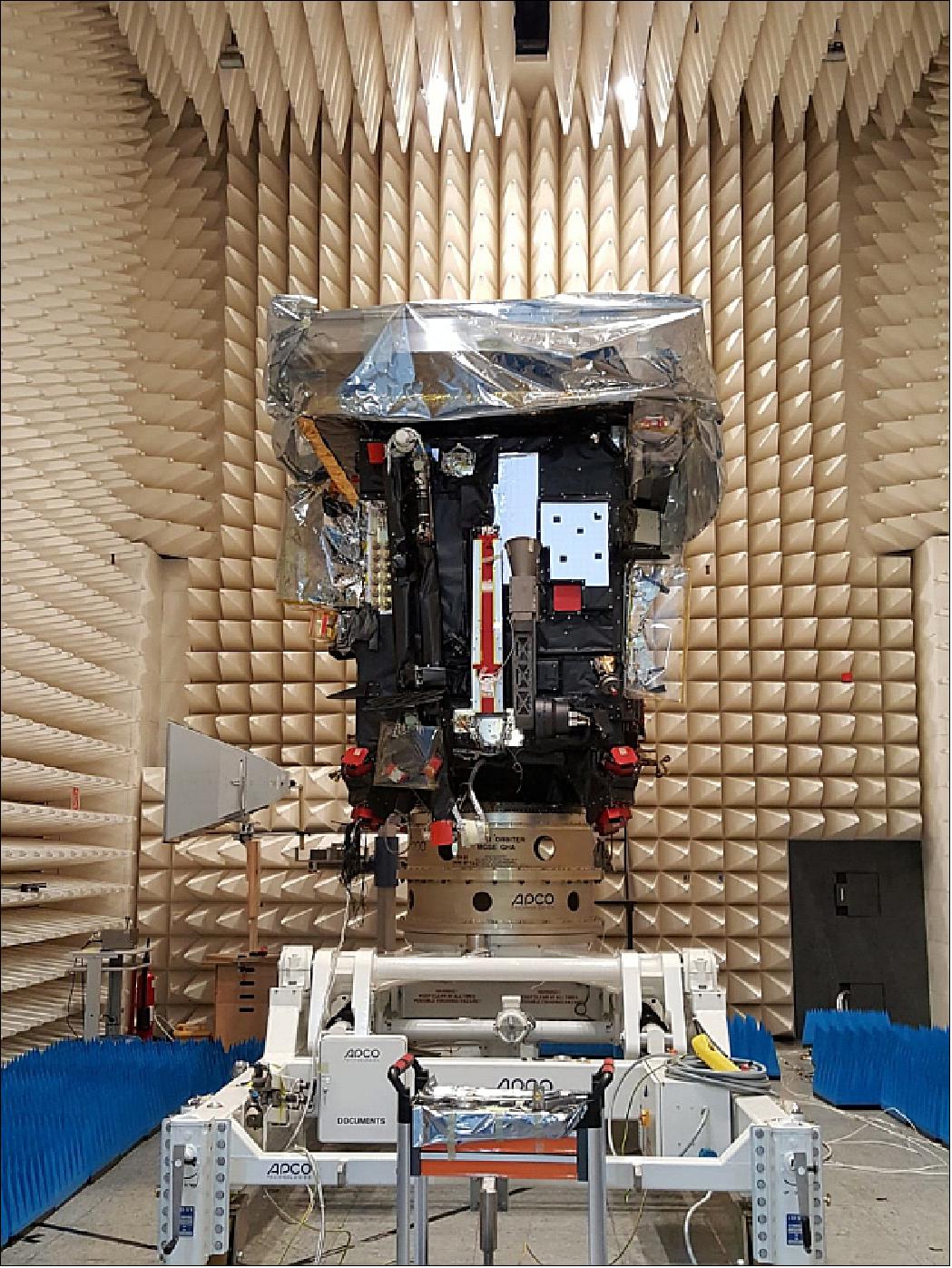
- While most spacecraft undergo only EMC testing, missions that involve measuring magnetic fields in space with exquisite accuracy – such as Solar Orbiter, which will measure the magnetic field of the solar wind with its Magnetometer (MAG) and with the SCM component of the RPW instrument, or magnetospheric plasma missions like ESA's Cluster and Swarm – require an additional set of tests to fully characterize their magnetic properties.

- These tests were conducted in a unique facility, the magnetic field simulation facility (MFSA), located just outside the IABG premises in a nearby forest to avoid interference with human-generated magnetic fields. In addition to that, the facility consists completely of non-magnetic materials like wood, and contains twelve 15-m coils – nearly as large as the building – to create a homogeneous magnetic environment that compensates Earth's own magnetic field, simulating outer space conditions.
- Performed between 18 and 25 June 2019, the testing first verified the magnetic behavior of the unpowered spacecraft, to make sure the magnetic field of Solar Orbiter is low enough so that the MAG instrument can operate at its most sensitive range. Later, the tests proceeded with electric current powering the spacecraft – first looking at direct current (DC) and finally alternating current (AC).
- The last scenario is especially important because it measured possible variations in the spacecraft's magnetic field during specific operations, for example with extra currents generated by the motors or by mobile elements such as the changeable optical filters used by the cameras on board to take images of the Sun.
- The analysis of the magnetic tests indicates that the mission requirements were met within the limits of the testing facility. After launch, in the even quieter environment of space, further measurements during the commissioning phase will complement the results of these tests to fully characterize the magnetic properties of the spacecraft.
- The spacecraft electromagnetic compatibility and magnetic cleanliness are especially important aspects for the science that Solar Orbiter will perform, not only for the RPW (EMC aspects) and MAG (magnetic properties) instruments. They are also key elements for the two particle detector instruments on board – the Solar Wind Plasma Analyzer (SWA) and the Energetic Particles Detector (EPD) – in order to reconstruct the path of incoming particles that might be deflected by any residual spacecraft electric or magnetic field.
- Throughout the mission development, a specific EMC working group, involving representatives of industry, ESA and all instrument teams, has looked into these aspects, setting stringent requirements for the overall spacecraft design. With this phase of the test campaign now completed, the teams are pleased to see that these choices eventually paid off, as the satellite checks off another important milestone on the way to launch.
• August 5, 2019: The image (Figure 10) was captured in 2015 from the site of the European Space Astronomy Center (ESAC) in Madrid, Spain, using a Solarmax 90 H-alpha telescope (9 cm in diameter) and a QHY5-II monochromatic camera. A grayscale 283-second video was initially created of the solar surface, and the best 30% of these 8222 frames were then combined and colored to produce this image. 7)
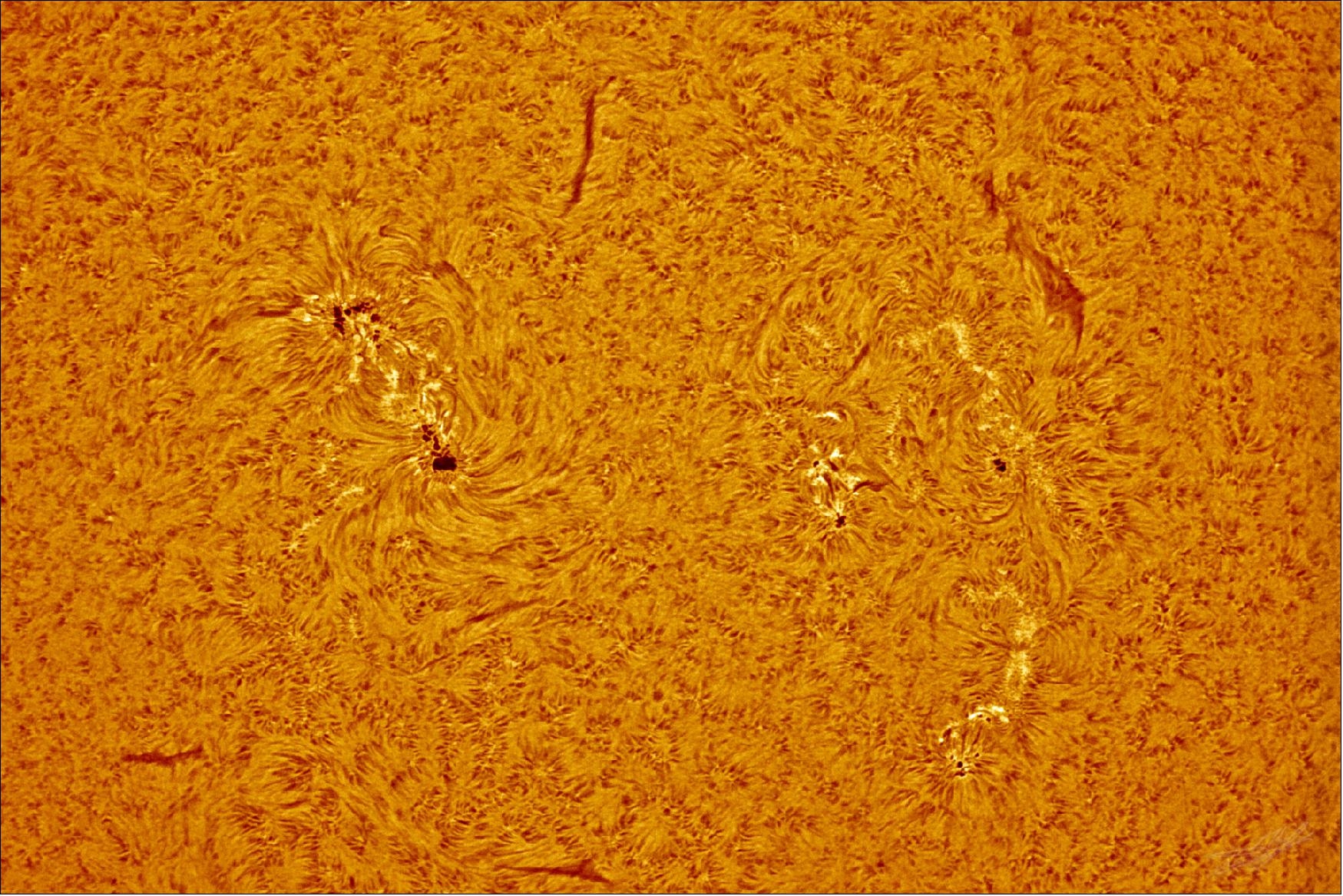
- The part of the Sun shown here is known as the chromosphere (literally ‘sphere of color'), one of the three main layers comprising our star. This layer sits just above the photosphere, the visible surface of the Sun with which we are most familiar. When viewed using a H-alpha telescope, as seen here, the chromosphere can reveal myriad intriguing features decorating the whole solar disc.
- Sunspots are not permanent fixtures on the Sun. They exist for days or weeks at a time, and come about as intense magnetic fields become twisted and concentrated in a given place, stifling the flow of energy from the Sun's interior to the surface. This leaves sunspots cooler than their surroundings, causing their darker appearance, while gas continues to flow both beneath and around these areas of magnetic disruption.
- The ESA/NASA Solar and Heliospheric Observatory (SOHO) mission, launched in 1995, has probed deeper into these features, characterized the flows in and around the spots themselves, and found that they form as magnetic fields break through the visible surface of the Sun. The work of missions such as SOHO will be continued by ESA's upcoming Solar Orbiter, the first medium-class mission selected for ESA's Cosmic Vision 2015-2025 Program.
- Solar Orbiter will explore how the Sun creates and manipulates a patch of space known as the heliosphere – a bubble blown by the solar wind, an ongoing stream of charged particles heading out from the Sun into the Solar System. The mission will also clearly image the solar poles for the first time, and track magnetic activity as it builds up and gives rise to powerful flares and eruptions. Planned for launch in February 2020, Solar Orbiter will make significant breakthroughs in our understanding of how our host star works.
• July 1, 2019: ESA's Solar Orbiter mission is being put through its paces to prepare it for facing the Sun following launch in February 2020. 8)

- The spacecraft is being tested to withstand the vibrations of launch, the vacuum of space, and the extreme temperature ranges and magnetic environment that it will experience as it journeys from Earth to within the orbit of the innermost planet, Mercury. The deployment mechanisms of instrument booms, antennas and solar arrays are also checked out.
- The solar arrays have to provide the required power throughout the mission over a wide range of distances from the Sun. Close to the Sun, the spacecraft will endure around 13 times the amount of solar heating that Earth-orbiting satellites experience, with temperatures in excess of 500ºC, so the solar arrays can also be rotated to avoid overheating when closest to the Sun.
- Solar Orbiter's mission is to provide new views of our star, in particular providing the first close-up observations of the Sun's poles. Its unique orbit will allow scientists to study the Sun and its outer atmosphere, the ‘corona', in much more detail than previously possible.
- We cannot usually see the corona because it is overwhelmed by the bright light of the Sun's surface itself. During a total eclipse however, when the Moon passes between Earth and the Sun, that light is blocked, revealing the beautiful white glowing corona around the Sun, its structures shaped by the Sun's magnetic field. This rare sight will be much sought after by astronomers in parts of South America on 2 July, who are getting ready to watch a total solar eclipse.
- We essentially live in the extended atmosphere of the Sun. The corona continuously expands and spreads into space, developing as the solar wind that interacts with the planets and beyond, sometimes leading to aurora and other space weather effects observed at Earth.
- Solar Orbiter will measure the solar wind and magnetic fields in the vicinity of the spacecraft while simultaneously taking high-resolution images of features on the Sun, linking the two together. This will give us unprecedented insight into how the Sun creates and controls its dynamic atmosphere, and how it interacts with the planets. Studying the Sun-Earth connection is fundamentally important to understanding how our Solar System works in its entirety.
- In addition to delivering ground-breaking science in its own right, Solar Orbiter also has important synergies with NASA's Parker Solar Probe. Coordinated observations will contribute greatly to our understanding of the Sun and its environment.
• April 4, 2019: While the Solar Orbiter spacecraft is at Ottobrunn, the Solar Orbiter mission control team located at ESA's ESOC mission control center in Darmstadt, Germany, is getting ready to establish data links to the satellite. 9)
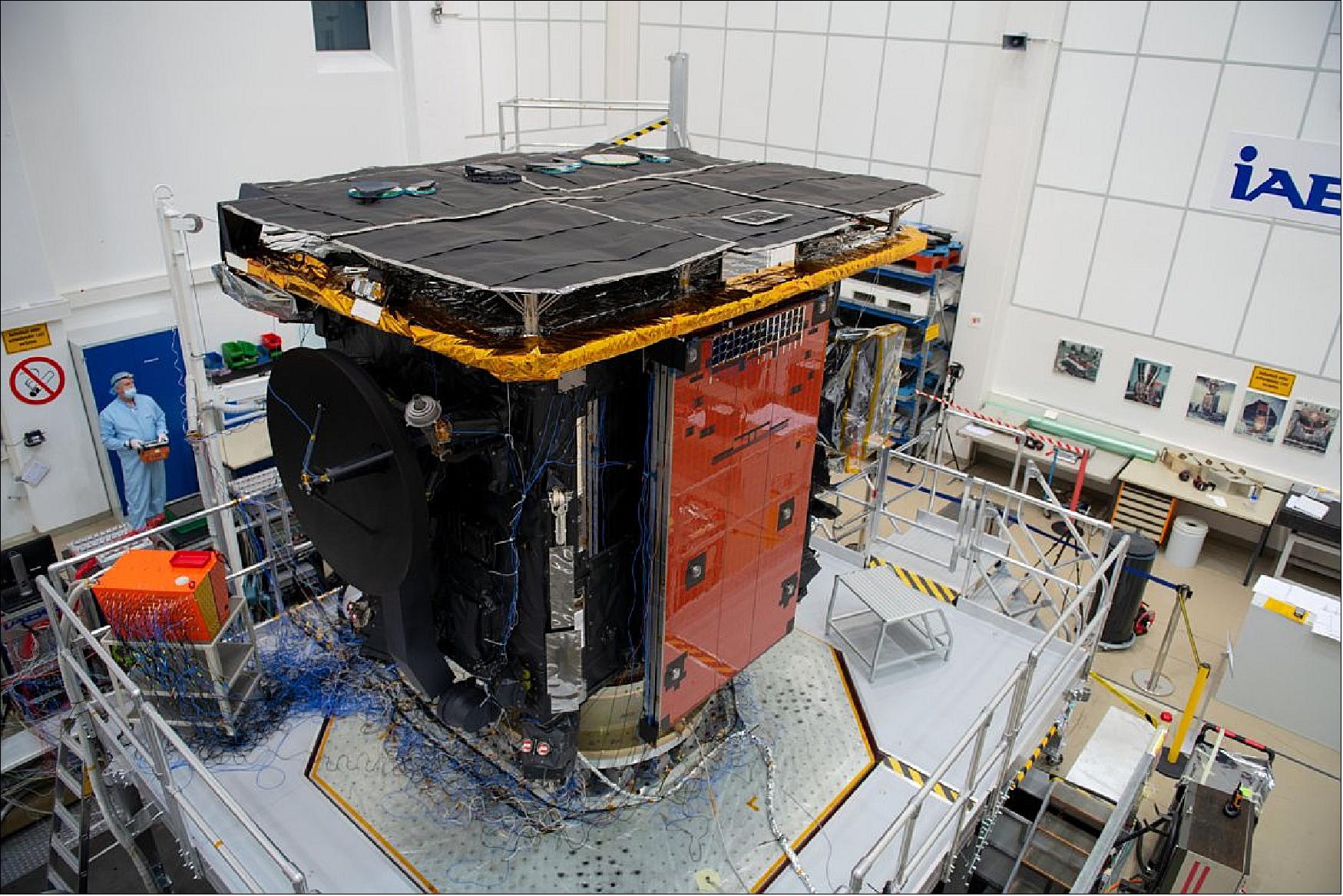
- The live links, dubbed ‘system validation tests', will see the flight team connect their mission control system to the spacecraft, as they will in future when the control systems on ground ‘talk' to the spacecraft in orbit via radio signals transmitted by a ground station antenna.
- "The prime objective of the system validation tests for any spacecraft is to validate that the mission control system can correctly send and receive telecommands to the satellite," says ESA's Jose-Luis Pellon-Bailon. "The tests also confirm that the spacecraft launch configuration is as expected by the post-launch Flight Control Procedures."
- An initial series of system validation tests were run last summer, when the Solar Orbiter was still at its manufacturer, Airbus Defence & Space UK, in Stevenage.
- "Since then, it has moved to Ottobrunn where we will run the next series of tests in early May and early August, lasting nine days in total and running around the clock," says Jose-Luis.
- "Solar Orbiter will then move to the US for launch from Cape Canaveral, where we will run a final series of connection tests at the end of November."
- Solar Orbiter will be launched in 2020 to study how the Sun creates and controls the heliosphere, the vast bubble of charged particles blown by the solar wind into the interstellar medium.
• April 1, 2019: Selected in 2011 as the first medium-class mission in ESA's Cosmic Vision program, Solar Orbiter was designed to perform unprecedented close-up observations of the Sun. The spacecraft carries a suite of 10 state-of-the-art instruments to observe the turbulent, sometimes violent, surface of the Sun and study the changes that take place in the solar wind that flows outward at high speed from our nearest star. 10)
- Having successfully completed its thermal-vacuum tests in December, Solar Orbiter has been subjected to a new series of arduous environmental tests at the IABG facility in Ottobrunn, Germany, including intense shaking of the spacecraft to ensure that it will survive the stress of launch.

- Solar Orbiter's unique orbit will allow scientists to study our parent star and its corona in much more detail than previously possible, and to observe specific features for longer periods than can ever be reached by any spacecraft circling the Earth. In addition, it will measure the solar wind close to the Sun, in an almost pristine state, and provide high-resolution images of the uncharted polar regions of the Sun.
- After the preliminary definition and design phase, the mission started its integration and qualification in 2016, including environmental testing of the spacecraft as well as validation of all mission systems and subsystems.
- The first phase of Solar Orbiter's environmental testing campaign was conducted in IABG's special thermal-vacuum chamber in December 2018. Inside the chamber, powerful lamps are used to produce a ‘solar beam' that simulates the Sun's radiation to demonstrate that the spacecraft can sustain the extreme temperatures it will encounter in the Sun's vicinity.
- The image of Figure 14 was taken with an infrared camera, and the coloring indicates the temperatures of the spacecraft surface, corresponding to the range indicated in the color bar on the right-hand side. During this thermal-vacuum test on the spacecraft, the solar beam was used at its maximum flux of about 1800 W/m2, reaching temperatures up to 107,6 ºC. An additional thermal-vacuum test was conducted on the heat shield that protects the entire platform from direct solar radiation: during this test, which used infrared plates to simulate the Sun's heat, the heat shield reached higher temperatures, up to 520 ºC, similar to what it will experience during operations.
- In this view, the spacecraft panel that will face the Sun is visible on the left, covered with the heat shield. The dark elements visible in the upper part of the panel are sliding doors that will open the path for sunlight to reach the remote-sensing instruments during science operations. Some of the thrusters that will be used to control the spacecraft orbit and to perform maneuvers are hosted on the panel that is visible on the right in this view.
http://www.esa.int/ESA_Multimedia/Videos/2019/04/Solar_Orbiter_during_thermal-vacuum_tests/(lang)
Figure 15: This video shows the Solar Orbiter spacecraft during tests conducted in December 2018 in the thermal-vacuum chamber at the IABG facility in Ottobrunn, Germany (video credit: Airbus Defence and Space/IABG)
Filmed with an infrared camera, the video shows the rotation of the spacecraft. It starts by displaying the +Z panel, on which the medium-gain antenna and some of the thrusters are located, slowly revealing the Sun-facing panel of the spacecraft, covered with a heat shield to protect the entire platform from direct solar radiation. Sliding doors on the heat shield, visible in the upper part of the Sun-facing panel in this view, cover the feed-throughs of most of the remote-sensing instruments. - Inside the chamber, powerful lamps simulate the Sun's radiation to demonstrate that the spacecraft can sustain the extreme temperatures it will encounter in the Sun's vicinity.
- After completing the thermal-vacuum tests, Solar Orbiter also successfully concluded the mechanical testing phase, including intense vibration tests, shaking the spacecraft to ensure that it will survive the stress of launch.
• January 30, 2019: The spacecraft flight model has been readied by prime contractor Airbus in the UK. Due to launch in 2020, Solar Orbiter will observe the Sun and measure the solar wind from a minimum of 42 million km away, or less than one-third Earth's distance. As a result, the spacecraft will be subjected to around 13 times the amount of solar heating that Earth-orbiting satellites experience, and to temperatures in excess of 500°C. 11)
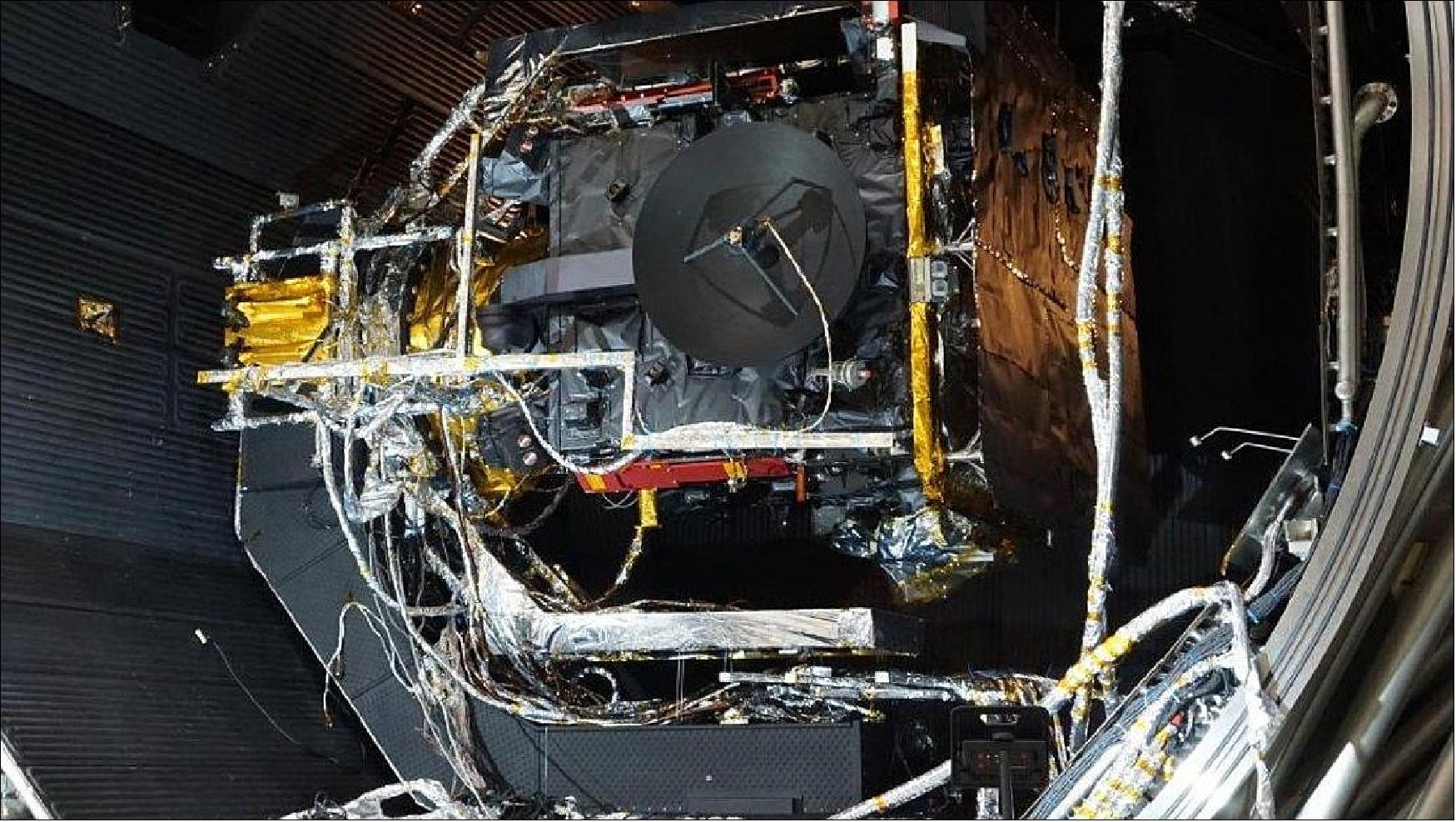
- Solar Orbiter's main body will be protected from direct sunlight by a Sun-facing multi-layer titanium heat shield. The 1.1-m diameter high-gain antenna seen here will be deployed from the body of the spacecraft to, transmit science data back to Earth in high-bandwidth X-band.
- The antenna's black color is unusual. It is covered with the same kind of protective, high temperature coating as the front of Solar Orbiter's heatshield, based on burnt-bone charcoal. Developed by the Irish company ENBIO, this ‘Solar Black' coating was selected because it can maintain the same color and surface properties despite years of exposure to unfiltered sunlight and ultraviolet radiation.
- The high-gain antenna is placed at the end of a maneuverable 1-m long boom allowing Solar Orbiter to maintain a reliable, high-bandwidth link with Earth throughout its science-gathering phase.
- This test campaign – using powerful lamps to simulate the Sun's radiation – began by simulating the conditions the spacecraft will undergo as it maneuvers to its operational orbit through flybys of Earth and Venus.
- "During 99% of the mission operations time, the heatshield will protect Solar Orbiter, but there will be more than a dozen maneuvers when one of the side panels will be exposed to sunlight," explained Claudio Damasio, ESA's Solar Orbiter project thermal engineer. "Therefore, we need to know how the Proto Flight Model responds when the exterior of the insulation on these panels reaches a temperature of about 120–150 degrees Celsius."
- For practical reasons, some elements, such as the solar arrays and the instrument boom, were not integrated with the spacecraft during the test. They were integrated this month on the spacecraft, which will next undergo a series of mechanical and electromagnetic compatibility tests.
• September 20 , 2018: After several years of development, the main communications dish on ESA's Solar Orbiter is now ready to be integrated with the pioneering spacecraft. 12)
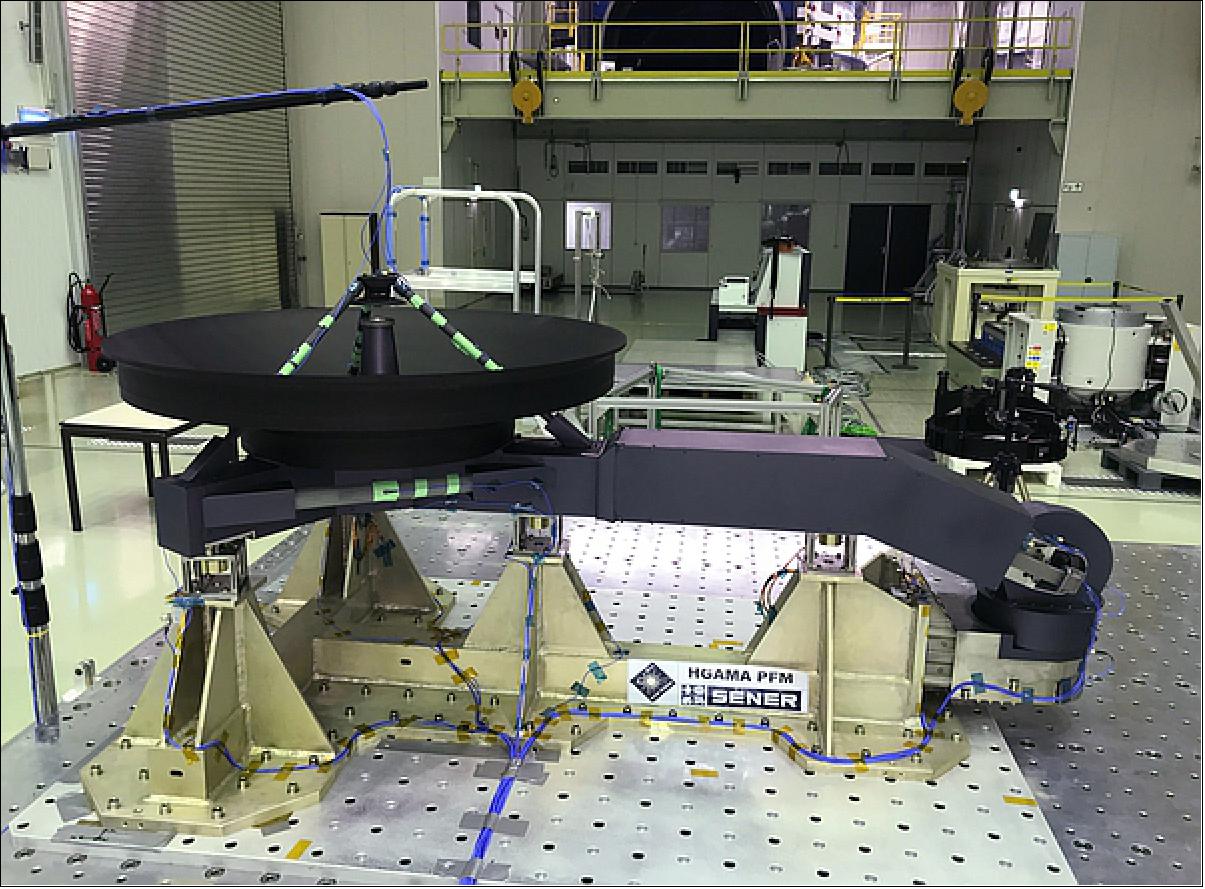
- Solar Orbiter's HGA is located on the end of a 1-m long, movable boom. The boom can extend above or below the spacecraft's heat shield – which provides protection from the high levels of solar flux near perihelion – to achieve a reliable link with ground stations on Earth and transmit the huge volumes of data generated by the mission's scientific payload.
- Besides the challenging thermal environment, the antenna must also be made of conducting material to avoid a build-up of electrostatic potential that would have a negative impact on the payload's capability to perform solar wind measurements.
- To this aim, the 1.1-m diameter HGA reflector is made of titanium alloy, covered with a new type of high-temperature coating that is based on burnt-bone charcoal. Developed by Irish company EnBio, this Solar Black paint was chosen because it can maintain the same 'thermo-optical' properties even after years of exposure to unfiltered sunlight and ultraviolet radiation.
- Due to the mission's unique orbit, the throughput of the data downlink is highly variable – from tens of bits per second up to 1 Mbit/s. Most of the time, data will, therefore, initially be stored in Solar Orbiter's onboard memory before it is sent back to Earth at the earliest possible opportunity.
• March 28, 2018: Solar Orbiter will be used to examine how the Sun creates and controls the heliosphere, the vast bubble of charged particles blown by the solar wind into the interstellar medium. The spacecraft will combine in situ and remote sensing observations to gain new information about the solar wind, the heliospheric magnetic field, solar energetic particles, transient interplanetary disturbances and the Sun's magnetic field. 13)
- Scheduled for launch in 2020, the mission will provide close-up, high-latitude observations of the Sun. Solar Orbiter will have a highly elliptic orbit – between 0.9AU at aphelion and 0.28AU at perihelion. It will reach its operational orbit three-and-a-half years after launch by using GAMs (Gravity Assist Maneuvers) at Earth and Venus. Subsequent GAMs at Venus will increase its inclination to the solar equator over time, reaching up to 25° at the end of the nominal mission (approximately 7 years after launch) and up to 34° in the extended mission phase.
- Being close to the Sun allows for observations of solar surface features and their connection to the heliosphere for much longer periods than from near-Earth vantage points. The view of the solar poles will help us to understand how dynamo processes generate the Sun's magnetic field.
- The science payload of Solar Orbiter comprises both remote-sensing and in situ instruments. The in situ instruments will operate continuously. During each orbit, the complete instrument suite will be operated around closest approach, and at the minimum and maximum heliographic latitudes – the segments of the orbit where Solar Orbiter will be farthest below and above the solar equator. Since the orbital characteristics will change in the course of the mission, individual orbits will be dedicated to specific science questions.
• October 2, 2017: Now being fitted with its state-of-the-art instruments, ESA's Solar Orbiter is set to provide new views of our star, in particular providing close-up observations of the Sun's poles. 14)
- Following its launch in February 2019 and three-year journey using gravity swingbys at Earth and Venus, Solar Orbiter will operate from an elliptical orbit around the Sun. At its closest it will approach our star within 42 million km, closer than planet Mercury.
![Figure 18: An artist's impression of Solar Orbiter in front of the stormy Sun is depicted here. The image of the Sun is based on one taken by NASA's Solar Dynamics Observatory. It captures the beginning of a solar eruption that took place on 7 June 2011. At lower right, dark filaments of plasma arc away from the Sun. During this particular event, it watched the plasma lift off, then rain back down to create ‘hot spots' that glowed in ultraviolet light [image credit: ESA/ATG medialab; Sun: NASA/SDO/ P. Testa (CfA)]](https://eoportal.org/ftp/satellite-missions/s/SolODevelopment_300322/SolODevelopment%20_Auto4.jpeg)
- Solar Orbiter's over-arching mission goals are to examine how the Sun creates and controls the heliosphere, the extended atmosphere of the Sun in which we reside, and the effects of solar activity on it. The spacecraft will combine in situ and remote sensing observations close to the Sun to gain new information about solar activity and how eruptions produce energetic particles, what drives the solar wind and the coronal magnetic field, and how the Sun's internal dynamo works.
- Its 10 scientific instruments are in the final stages of being added to the spacecraft before extensive tests to prepare it for the 2019 launch from Cape Canaveral, USA. Solar Orbiter is an ESA-led mission with NASA participation.
• September 2017: The manufacture and delivery of spacecraft FM units and subsystems is approaching completion, in particular all AOCS (Attitude and Orbital Control System) equipment has been delivered. The spacecraft FM integration is ongoing. Functional testing continues on the two spacecraft Engineering Test Benches and on the FM avionics already installed on the spacecraft. 15)
- Of the remaining spacecraft units in production, the FM heat shield is ready for environmental tests; the solar generator QM wing completed its environmental testing; the first FM wing is under testing, and the second FM wing is being integrated. The payload radiator panel is being fitted with its thermal management equipment. Solutions for straylight protection, for surface conductivity and for cleanliness and contamination control are being manufactured.
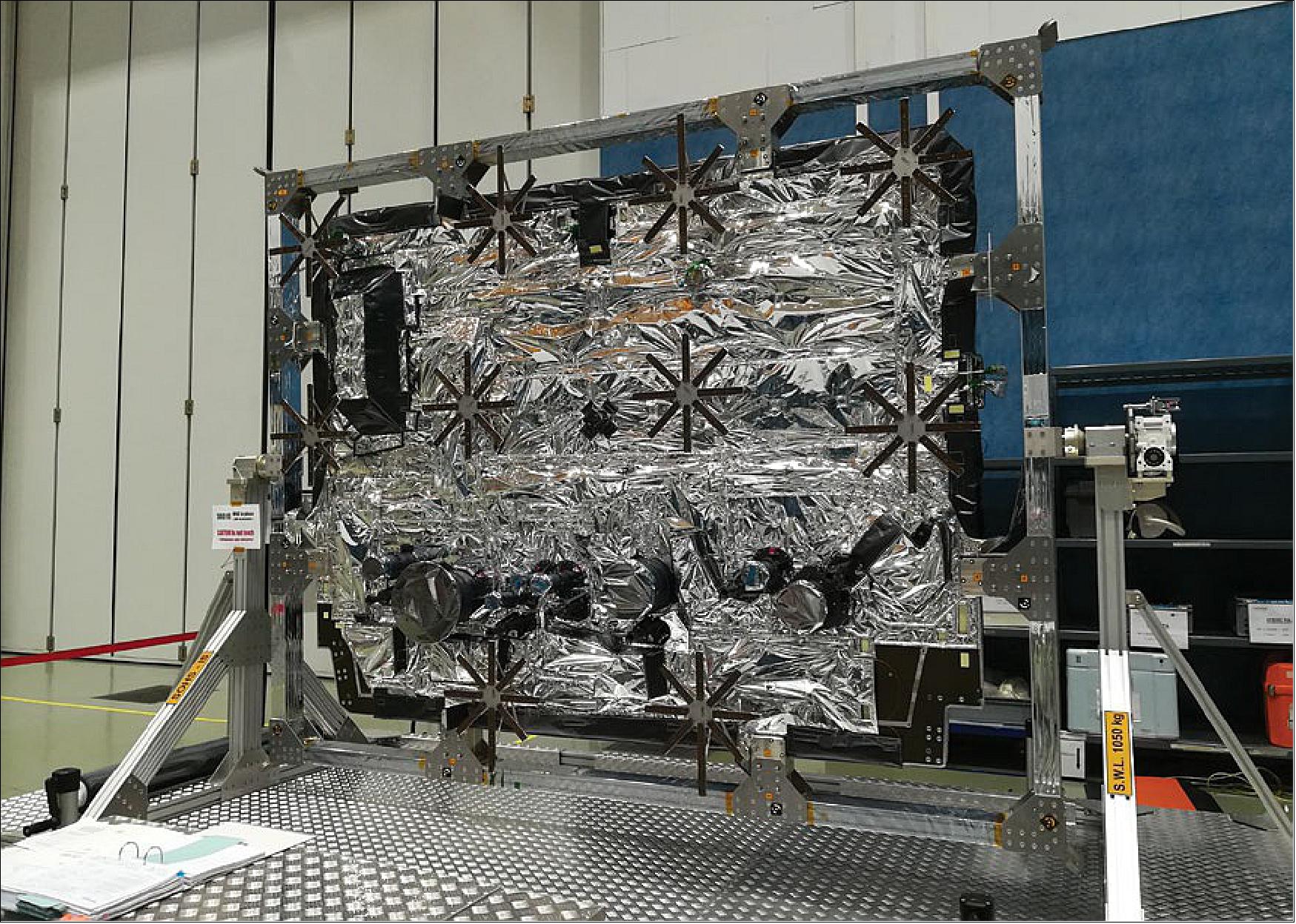
• On April 28, 2017, TAS (Thales Alenia Space) announced two milestones in the Solar Orbiter mission to investigate the Sun and the heliosphere. It has completed construction of the heat shield on behalf of Airbus Defence and Space for ESA's Solar Orbiter spacecraft, and delivered to the Italian space agency ASI the scientific instrument METIS (Multi-Element Telescope for Imaging and Spectroscopy). 16)
- The heat shield, designed and produced by TAS in Turin, Italy for Airbus DS, has been shipped to the IABG facility in Ottobrunn, Germany for final thermal-mechanical acceptance tests. The heat shield was a daunting technological challenge because it will have to protect the satellite from the intense solar radiation present at such close range. It is sized to keep the entire satellite in the shade, radiating the accumulated heat into deep space. The outermost layer is made of titanium, and can withstand temperatures up to 600ºC.
- With these two latest milestones in the Solar Orbiter program, Thales Alenia Space continues to confirm its technological expertise for leading-edge space exploration endeavors. The company has already developed advanced scientific instruments for the Planck and GOCE missions, and will provide sophisticated radio instruments for the upcoming BepiColombo mission to explore Mercury and the Euclid satellite designed to map the geometry of the "dark universe".
• April 26, 2017: In late Fbruary 2017, CSL (Centre Spatial de Liège, Belgium) reported already on the EUI (Extreme Ultraviolet Imager) assembly. Two months later, not only is this instrument fully assembled, it has also been aligned, thermal-vacuum tested, and has undergone an extensive vibration testing ("Shaken, not stirred"). Last week, it has been shipped to PTB (Physikalisch-technische Bundesanstalt) in Germany for final calibration at a synchrotron source (particle accelerator). The final issues are being addressed and the instrument is ready for its scheduled delivery to ESA in May. 17)
• March 16, 2015: The Structural and Thermal Model (STM) for the Solar Orbiter mission left the Airbus Defence and Space premises in Stevenage (UK) at the end of March for mechanical testing at IABG in Ottobrunn, Germany. This test is a crucial stage in the development of the Solar Orbiter. At the end of this three-month test campaign, the STM will be shipped back to Stevenage for further building before being shipped again to IABG for thermal testing. 18) 19) 20)
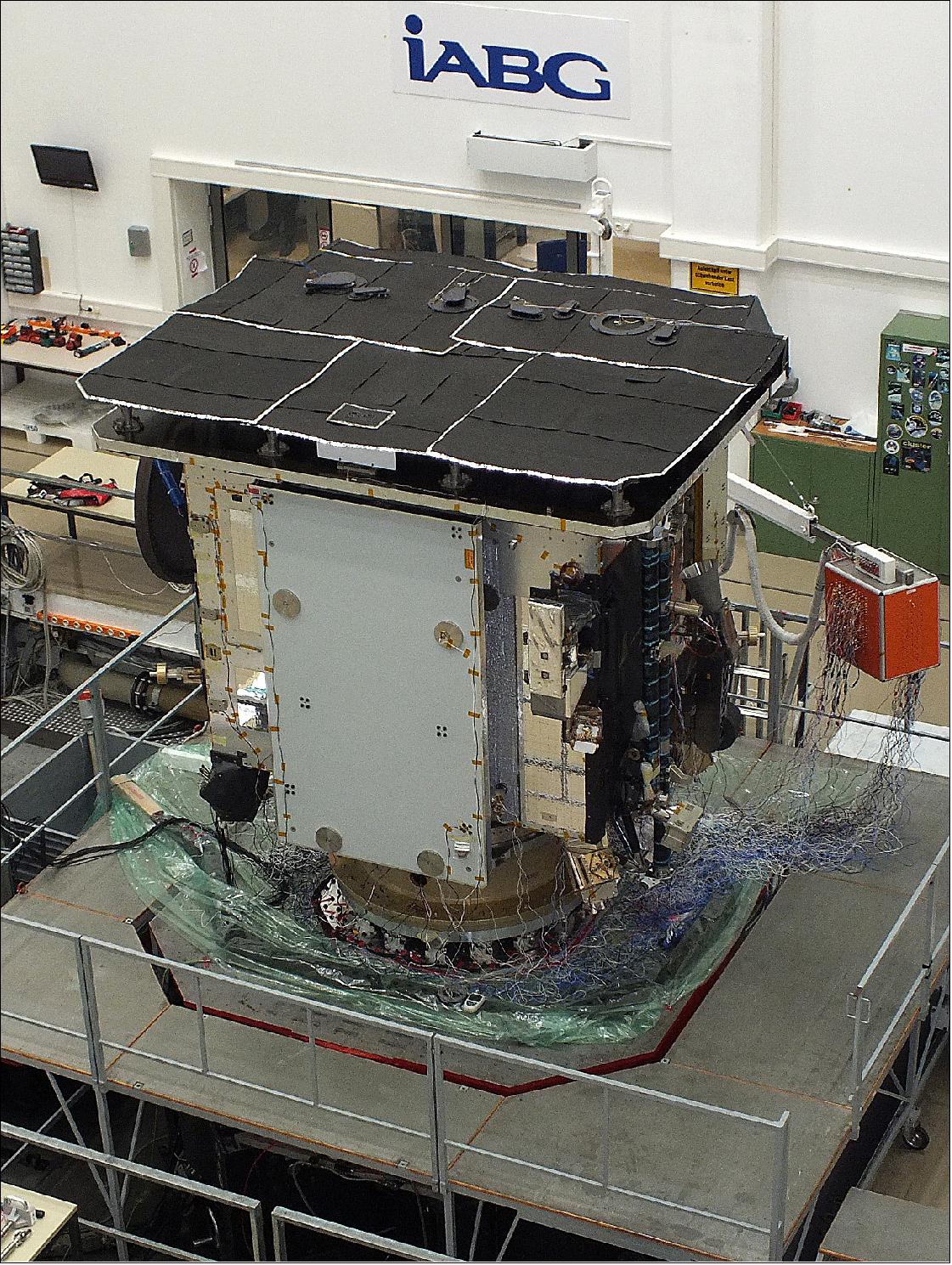
• On March 13, 2015, the Solar Orbiter passed a major milestone when the heat shield was attached to the engineering model (Figure 21, left). MSSL (Mullard Space Science Laboratory) of UCL (University College London) has a significant involvement in the Solar Orbiter mission on both the remote sensing and in-situ sides. On the remote sensing side, the electronics box for the EUI (Extreme Ultraviolet Imager) is being built at MSSL, while on the in-situ side, MSSL is the PI (Principle Investigator) institute for the SWA (Solar Wind Analyzer) suite of instruments. 21)
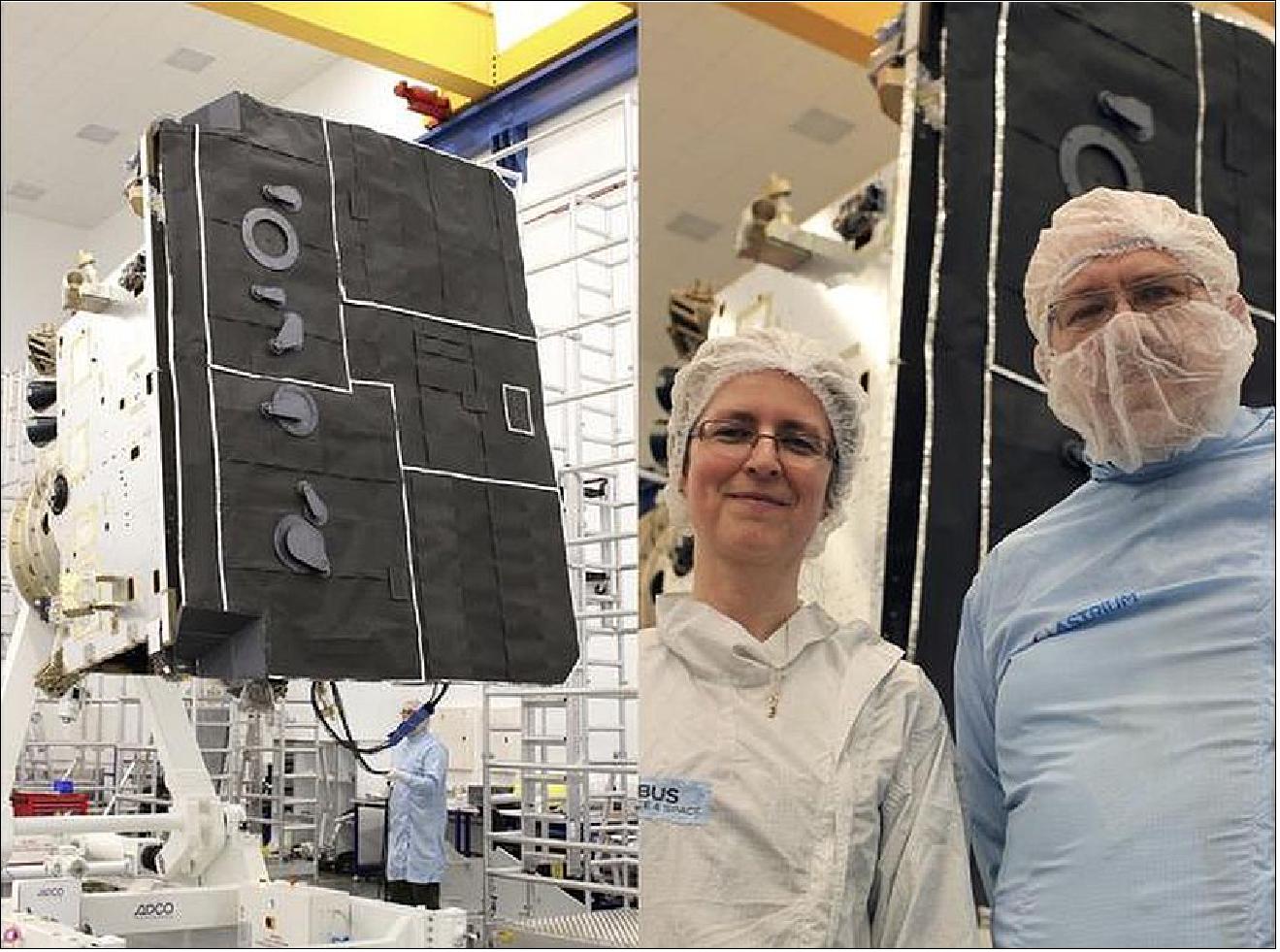
• Fall 2014: Six instruments have passed CDRs: SolOHI, MAG, SPICE, EUI, PHI and EPD. The STIX and SWA CDRs were performed and awaiting outcome. Two CDRs (RPW, METIS) will follow. Various instrument STM (Structural/Thermal Model) items have been delivered to prime contractor facilities and integrated on the STM spacecraft. 22)
• June 3, 2014: ESA's Solar Orbiter mission has undergone its latest major test: its protective shield has been subjected to concentrated sunlight to prove it can cope with the fierce temperatures close in to our parent star. The outcome ensures it will balance solar illumination, the cold of deep space and internal heat sources to maintain the perfect operating temperature. 23)
• May 2014: Members of ESA's Solar Orbiter team watch expectantly as an essential part of the spacecraft is lowered into Europe's largest vacuum chamber: the multi-layered shield (of size 3.1 m x 2.4 m) that will protect their probe from the Sun's remorseless glare. 24)
- ENBIO, a surface treatment technology enterprise based on the Belfield Campus in Nova UCD (University College Dublin, Ireland), was awarded the contract to coat the main heatshield for ESA's Solar Orbiter mission. After undergoing and completing an extreme test process at the ESA/ESTEC in the Netherlands, the ENBIO solution was approved for use on flight hardware. The solution combines some old and new thinking: a pigment used in 30,000-year-old cave paintings and ENBIO's patented CoBlast process. 25)
- To provide such a system, ENBIO has been collaborating with ESA and Airbus Defence & Space since 2011, to develop a novel protective CoBlast Skin, called SolarBlack. It is critical that the Skin maintains its thermo-optical properties, despite years of exposure to extreme infrared and ultraviolet radiation, while not shedding material or outgassing vapor, which would risk contaminating Solar Orbiter's highly sensitive instruments. Additionally, the Skin needs to be conductive to avoid the build-up of static charge which might threaten a disruptive or destructive discharge to the craft. 26)
- SolarBlack is a CoBlast Skin of black calcium phosphate, which will be applied to the outermost titanium sheet of Solar Orbiter's multi-layered heatshield. It will be deployed via ENBIO's patented CoBlast process, which replaces, in one process step, a metal's natural oxide surface layer with a desired functional Skin – in this case SolarBlack. What makes CoBlast unique is the direct bond produced between the desired Skin and the underlying metal, without a troublesome oxide layer, providing the durability and adhesion required for skin integrity under such extreme conditions. CoBlast is also an environmentally friendly process, requiring no chemical, vacuum or thermal inputs. - SolarBlack has been qualified to meet the demands of this mission and is being specified on an increasingly wide variety of additional applications including sensor internals and heatshields.

Legend to Figure 22: The Large Space Simulator is Europe's largest vacuum chamber for the sunshield's trial by sunlight. As its crucial test begins, all air will be extracted to produce space-quality vacuum, while the chamber walls are pumped with –190°C liquid nitrogen to mimic the extreme cold of deep space. - Then the light from 19 xenon lamps, each consuming 25 kW, will be tightly focused by mirrors into a concentrated beam of artificial sunlight upon the sunshield for a number of days.
• The CDR (Critical Design Review) for the spacecraft and the payload started in September 2013.
References
1) "Here comes the Sun!," ESA / Enabling & Support / Operations, 7 February 2020, URL: http://www.esa.int/Enabling_Support/Operations/Here_comes_the_Sun
2) "ESA's missions to the Sun," ESA Science & Exploration, 3 February 2020, URL: http://www.esa.int/ESA_Multimedia/Videos/2020/02/ESA_s_missions_to_the_Sun
3) "Warming up for the Sun," ESA / Enabling & Support / Operations, 21 January 2020, URL: http://www.esa.int/Enabling_Support/Operations/Warming_up_for_the_Sun
4) "Solar Orbiter launch campaign begins," ESA / Science & Exploration / Space Science / Solar Orbiter, 21 November 2019, URL: http://www.esa.int/Science_Exploration/Space_Science/Solar_Orbiter/Solar_Orbiter_launch_campaign_begins
5) "Solar Orbiter ready to depart Europe," ESA, 18 October 2019, URL: http://www.esa.int/Science_Exploration/Space_Science/Solar_Orbiter/Solar_Orbiter_ready_to_depart_Europe
6) "#5: Electric and magnetic fields under control for Solar Orbiter," ESA Science & Technology, 23 September 2019, URL: https://sci.esa.int/web/solar-orbiter/-/-5-electric-and-magnetic-fields-under-control-for-solar-orbiter
7) "A sphere of color," ESA Space Science Image of the Week, 05 August 2019, URL: http://www.esa.int/spaceinimages/Images/2019/08/A_sphere_of_colour
8) "Solar Orbiter array deployment test," ESA, Space Science Image of the Week, 01 July 2019, URL: http://www.esa.int/spaceinimages/Images/2019/06/Solar_Orbiter_array_deployment_test
9) "Connecting to Solar Orbiter," ESA, Operations image of the week, 4 April 2019, URL: http://m.esa.int/spaceinimages/Images/2019/04/Connecting_to_Solar_Orbiter
10) "Solar Orbiter during thermal-vacuum tests," ESA, 1 April 2019, URL: http://m.esa.int/spaceinimages/Images/2019/04/Solar_Orbiter_during_thermal-vacuum_tests
11) "Thermal testing of Solar Orbiter," ESA, Technology image of the week, 30 January 2019, URL: http://m.esa.int/spaceinimages/Images/2019/01/Thermal_testing_of_Solar_Orbiter
12) "Antenna's European journey to join Solar Orbiter," ESA, 20 September 2018, URL: http://sci.esa.int/solar-orbiter/60671-antenna-s-european-journey-to-join-solar-orbiter/
13) "Mission Operations," ESA, 28 March 2018, URL: http://sci.esa.int/solar-orbiter/44181-mission-operations/
14) "Facing the Sun," ESA 2 Oct. 2017, URL: http://m.esa.int/spaceinimages/Images/2017/10/Facing_the_Sun
15) "Solar Orbiter: Programs in Progress," ESA Bulletin 170, Sept. 2017, p. 53, URL: http://esamultimedia.esa.int/multimedia/publications/ESA-Bulletin-170/offline/download.pdf
16) "Thales Alenia Space delivers METIS instrument and heat shield for Solar Orbiter," TAS Press Release, 28 April 2017, URL: https://www.thalesgroup.com/en/worldwide/space/press-release/thales-alenia-space-delivers-metis-instrument-and-heat-shield-solar
17) "Works in progress!," STCE (Solar Terrestrial Center of Excellence), April 26, 2017, URL: http://www.stce.be/news/387/welcome.html
18) "From Stevenage to the Sun," UKSA, March 16, 2015, URL: https://www.gov.uk/government/news/from-stevenage-to-the-sun
19) "Solar Orbiter – structural and thermal model of heat shield," ESA, March 11, 2015, URL: http://sci.esa.int/solar-orbiter/55590-solar-orbiter-at-stevenage/
20) "Airbus Defence and Space ready to deliver Solar Orbiter Structural and Thermal Model for mechanical testing," Airbus DS, March 13, 2015, URL: http://airbusdefenceandspace.com/wp-content/uploads/2015/03/sp-04-2015-n-13032015-eng.pdf
21) "Solar Orbiter heat shield attached," MSSL, March 23, 2015, URL: https://www.ucl.ac.uk/mssl/news/2015/mar/solar-orbiter-heat-shield-attached
22) "Solar Orbiter," ESA Bulletin, No 160, November 2014, p. 70
23) "Solar Orbiter's shiled takes sun's heat," ESA, June 3, 2014, URL: http://www.esa.int/Our_Activities/Space_Engineering/Solar_Orbiter_s_shield_takes_Sun_s_heat
24) "Solar Orbiter sunshield," ESA, May 7. 2014, URL: http://www.esa.int/spaceinimages/Images/2014/05/Solar_Orbiter_sunshield
25) Barry Twomey, "UCD engineers protect the closest man-made object to the sun," Engineers Journal.ie, Feb. 10, 2015, URL: http://www.engineersjournal.ie/enbio-coblast-ucd/
26) "Solar Orbiter," ENBIO, URL: http://enbio.eu/solar-orbiter
The information compiled and edited in this article was provided by Herbert J. Kramer from his documentation of: "Observation of the Earth and Its Environment: Survey of Missions and Sensors" (Springer Verlag) as well as many other sources after the publication of the 4th edition in 2002. - Comments and corrections to this article are always welcome for further updates (eoportal@symbios.space).